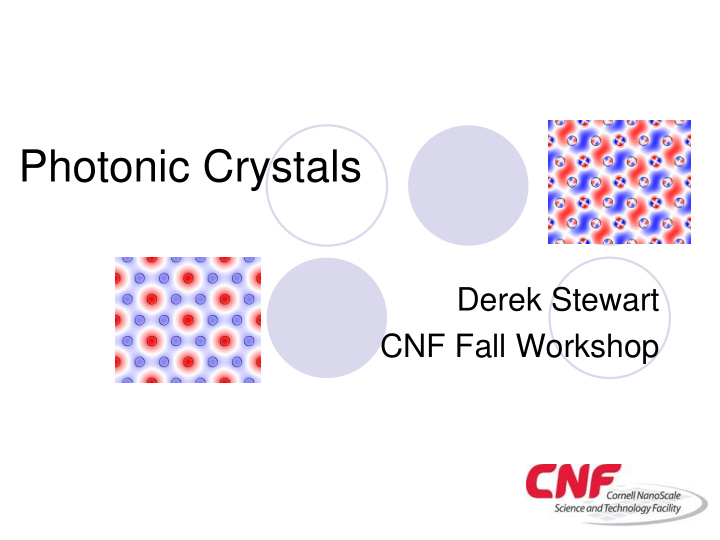



Photonic Crystals Derek Stewart CNF Fall Workshop
What are photonic crystals? Photonic crystals are periodic systems that consist of separate high dielectric and low dielectric regions. The periodicity or spacing determines the relevant light frequencies - high dielectric lattice of air spheres in titania matrix low Wijnhoven & Vos, Science , 1998) dielectric Ho,Chan,Soukoulis, (1990) –predicted dielectric spheres in diamond structure should have a band gap Yablonovitch (1991) First photonic crystal with microwave band gap “In the course of four years, my loyal machinist, John Gural, drilled more than 500,000 holes in dielectric plates… It became unnerving as we produced failure after failure.” (Yablonovitch, Scientific American, 1991)
What can you do with a photonic crystal? Trap Light A single defect in a photonic crystals acts like a resonant cavity with a defect level in the band gap. Right turns with photons Photonic crystals prevent photons in the band gap from propagating in the material. If we create a line defect in the structure, it will act like a waveguide. Negative index of refraction – Flat lens http://ab-initio.mit.edu/photons/bends.html Parimi et al., 2003, Nature 426 404 and much more…
Catching up with Mother Nature… Just a 4 billion year head start… Sea Mouse Biro et al, Phys. Rev. E, (2003) Parker et al, Nature (2001)
Borrowing from solid state physics… Matrix e - Crystal (Lattice of Ions) Photonic Crystal (Matrix and spheres have different dielectric properties) •Electrons scatter in the periodic lattice •Photon scatters in periodic lattice • Schrodinger’s Equaton H ψ = E ψ • Maxwell’s equations � ☺ •interacting particles •non-interacting particles! •solve approximately – plane waves, MST,… •solve exactly - plane waves, MST,… Band Diagram - Electron standing waves Band Diagram - standing waves Allowed energies (bands) Allowed frequencies (bands) Forbidden energies (band gaps) Forbidden frequencies (band gaps)
Finding the Photonic Band Structure � We need to solve Maxwell’s Equations. If there are no source terms, we can write Maxwell’s Equations just in terms of the magnetic field, H r r ω ⎡ ⎤ 2 1 ∇ × ∇ × = ε = H H 2 ⎢ ⎥ n ε ⎣ ⎦ 2 c scalable equation � Photonic crystals * − ω i t e standing waves – definite frequency periodic system – use Bloch theorem and move to k space! TM,TE modes ( ) r r r 2 ( ) r ∑∑ + ⋅ = i k G r , ˆ H r h e e λ λ G r λ = 1 G reciprocal lattice vectors * MoNOS – Universiteit Leiden
Rewriting the equation… We can now rewrite the equation for H as a matrix equation, ⎛ ⎞ ω 2 ∑ ⎜ ⎟ = H h h ⎜ ⎟ ′ ′ G , G G G 2 ⎝ ⎠ eigenvectors c ′ G eigenvalues Periodic structure, so we only include k points in the Brillouin Zone. M L Γ
Solving for the photonic band structure Brute force approach: direct diagonalization – N 2 memory store, N 3 diagonalization, slow for bigger problems Second approach: Perhaps you only want a few bands, p << N. Then we can use iterative approaches like the Davidson method. Memory storage pN, diagonalization p 2 N ( Implemented in MIT Photonics Band) You can pick out defect states in the band gap this way (Tutorial this afternoon)
A Starter System (MPB Tutorial) Triangular Lattice: Collection of Dielectric Rods in Air TM Gap from band 1 (0.275065617068082) to band 2 (0.446289918847647), 47.4729292989213% TM Gap from band 3 (0.563582903703468) to band 4 (0.593059066215511), 5.0968516236891% TM Gap from band 4 (0.791161222813268) to band 5 (0.792042731370125), 0.111357548663006% TM Gap from band 5 (0.838730315053238) to band 6 (0.840305955160638), 0.187683867865441% TM Gap from band 6 (0.869285340346465) to band 7 (0.873496724070656), 0.483294361375001% TE Gap from band 4 (0.821658212109559) to band 5 (0.864454087942874), 5.07627823271133% Electric Fields for TM fields in the photonic crystal (red high, blue low) TM Band 1 TM Band 3 TM Band 5 Band Structure
Frequency Domain (FD) versus FDTD (Static Choice) (Dynamic Choice) FD FDTD � Pros � Pros � Determines frequencies and � Excellent for evolution of eigenstates of the system. fields in a system (light � Photonic band structures transmission, propagation – � Able to find all eigenstates of wide applications) � the photonic crystal Can calculate resonant � Works well for periodic frequencies, but did we couple to all the resonant structures modes? � Cons � Cons � Poor choice for properties that � Frequencies and eigenstates change with time – must be calculated transmission, resonance separately decay ∆ω∝ 1/t simulation � � Always have to increase simulation time to increase frequency resolution
Conclusion � Photonic crystals offer ways to guide and trap light � Many of the approaches used in electronic structure theory can be applied to photonic crystals � MIT Photonic Bands provides one way to calculate system properties (more later…)
Recommend
More recommend